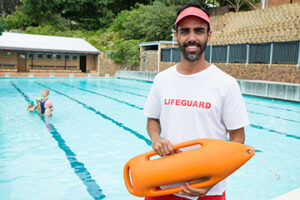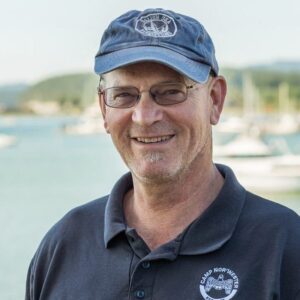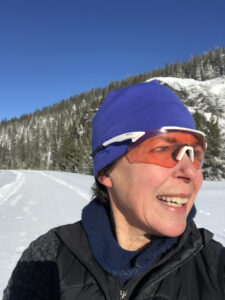Having well-trained lifeguards will be a crucial element in the Lopez Swim Center’s successful operation, and FLIP is getting a jump-start on lifeguard recruitment and training with Lopezians Paul Henriksen and Kathryn Tucker. These community movers and shakers are helping launch this vitally important program for the Swim Center.
FLIP: What motivated your decision to join FLIP’s efforts to build a Swim Center on Lopez Island?
Paul Henriksen (PH): I love to swim and I feel very strongly that every child should learn to swim. Swimming is a life skill. We have lost a few people in Hummel Lake since I moved here in the late ’70s.
Kathryn Tucker (KT): I spend more time on Lopez now and love to do what I can to serve the community. I think the pool will be a hub of community and I hope to be part of making it a great success.
FLIP: What are your main reasons for spearheading the Lifeguard Training Program?
PH: I want to ensure that our pool has good lifeguard coverage so we can all swim safely. And that dovetails into children being able to learn this essential life skill.
KT: As a lifeguard for many years when I was younger, I know what is involved (although now I have greater awareness of the great responsibility vested in lifeguards). I am eager to see the pool open and become a thriving community hub on the island, offering a new way for maintaining and nurturing fitness.
FLIP: As the leads for the Lifeguard Training Program, tell us what the mission is, and what the near-term goals are.
PH: We want to have enough experienced, certified lifeguards when the pool opens and also encourage Lopez youth to the possibilities of becoming lifeguards and serving this community.
KT: Our current goal is to encourage interest in lifeguard candidates and help them understand what is involved in gaining certification: the commitment of time and effort, and necessary physical fitness to succeed.
Because lifeguards have much more limited training and will always call 911 for EMS in any significant medical emergency, the pool lifeguards will need to interface with Lopez EMS. Beginning discussions with EMS will be among the next steps.
FLIP: The spring 2023 fundraiser is focused on obtaining life-saving equipment, but clearly the pool will need people who are trained to use this equipment. What have been your recruitment efforts thus far?
PH: We currently have a list and contact information for people who have expressed an interest in lifeguard training on Lopez. We hope to draw from that group, and will stay in touch as the pool and program develop.
We are eager to hear from anyone who has the motivation to become a lifeguard and help to staff the new pool. For more information or to get involved, please email info@lopezislandpool.org or sign up via FLIP’s volunteer portal at https://www.lopezislandpool.org/volunteer.
KT: Prospective lifeguards include competent swimmers with a strong physical fitness base who are interested in learning how to rescue swimmers in distress or drowning, and providing first-responder care to pool visitors who have a medical emergency out of the water, in or around the pool facility. Candidates could be high school juniors and seniors, Lopez Fire and EMS first responders, and just about anyone else who has the requisite interest and abilities.
FLIP: When the Lopez Swim Center is complete, who will be leading those trainings?
KT: The choices include prospective lifeguards going to the mainland for training; bringing a lifeguard trainer to do training at the Swim Center; and certifying one of the Swim Center’s lifeguards as a lifeguard instructor to offer training here.
FLIP: It seems like most people have pivotal swimming experiences that shaped their interaction around and in the water. What were yours?
KT: My dad taught me to swim at a very young age in Long Island Sound, off the beach in Clinton, Connecticut. Later, I swam on my high school swim team and became a certified lifeguard. I worked then and in college as a lifeguard.
I had plenty of opportunity to use my life-saving swimming skills when I started whitewater kayaking in college. I competed in whitewater slalom kayaking races and was a member of the U.S. Kayak team in some international competitions. I also paddled Olympic Flatwater kayak, and in 1984 was U.S National Champion in K2 Women’s and K2 Mixed (with fellow Lopez paddler David Halpern, who was on the Olympic team that year).
PH: I learned to swim at a very early age, I was probably 6 or 7 years old, in the Seattle area. Through high school, in the summer, I continued to swim daily in Lake Washington,
I received my first lifeguard training certificate via WSU in the late ’60s; I became SCUBA certified in the mid ’70s. In the mid ’80s, I rescued a swimmer who passed out in the shallow end of a pool. He was demonstrating how long he could hold his breath underwater (after returning from doing some free diving in Australia). It was an easy rescue because the water was only about 3 feet deep. In the early ’90s, I helped to keep a swimmer afloat in large waves off the Big Island of Hawai’i until lifeguards arrived on paddle boards. In the early 2000s, on a school field trip, I kept a student from drowning in a lake.
FLIP: Please share with our readers how you found Lopez—or how Lopez found you.
PH: I grew up in Seattle, just down the road from the Carpenters. They owned the Lopez Village Market, so I heard about Lopez frequently. During the summer of ’78, I came to Lopez on weekends to help build a cabin on Shoal Bay for the McArdle family. I visited Camp Nor’wester and was extremely impressed with that site and operation. A position was advertised in late summer for maintenance supervisor and caretaker for the camp. I applied, got the job, and moved to Lopez full time in November 1978. I met my wife, Christa Campbell, here in the early ’80s. In 1989, shortly after our first child was born, we were offered the position of directing the camp. The Camp had a large waterfront program and a saltwater swimming pool, so we needed lifeguards. In the spirit of not asking our staff to do anything we wouldn’t do, I kept up my certification by going to Friday Harbor and Bellingham (and even to Canoe Island one time), for recertification.
KT: I got to know Lopez through the Halpern family. David Halpern was a kayak teammate; that family owns a lovely piece of inland property on Lopez Hill. My then-husband (Scott Tucker) and I bought the adjacent undeveloped and remote 10 acres at the very top of Lopez Hill in 1991. Both of our kids, Torin and Montana, grew up spending a lot of time here, including in LIFRC summer camps, sailing, soccer, and horseback riding. We built our off-grid cabin ourselves. Our other neighbor is the Lopez Hill Forest Preserve, where I am often out on the trails. I love hiking, biking, trail running, cross-country skiing, and kayaking.
My day job is as a lawyer engaging advocacy to protect and expand the rights of the terminally ill. I am a long-time yoga practitioner and teacher. I blend my day job and my yoga teaching in offering workshops called “Preparing for the Final Asana: Law and Medicine at the End of Life and What Yoga has to Offer” at retreat centers, including Kripalu in western Massachusetts. In the summers, I lead Saturday morning yoga practice on the deck at the Islander.
Above: FLIP’s Lifeguard recruitment leaders Paul Henriksen (L) and Kathryn Tucker (R).
____________________________________________________________________
FLIP is thankful for Paul and Kathryn’s leadership in launching the Lopez Swim Center’s essential lifeguard recruitment and training program. For more information or to get involved, please email info@lopezislandpool.org or sign up via FLIP’s volunteer portal at lopezislandpool.org/volunteer.
FLIP’s mission is to bring greater health, water safety, and community to the people of San Juan County by building and operating a sustainable, low-maintenance, indoor/outdoor Swim Center that will serve the community for generations to come. Our vision is to have a safe place for our children to learn to swim; for all ages to have an accessible pool for recreation, socialization, exercise, and water therapy; and to foster a healthier and more connected island community. This spring’s GiveLopez and GiveBIG fundraiser focuses on raising money to purchase necessary lifesaving and accessibility equipment. Give online at https://www.wagives.org/story/Fliplifesavingequipment/
This series of informational interviews with pool experts and articles on pool progress was made possible by a generous grant from the Lopez Thrift Shop. We greatly appreciate their support in helping spread the word about the Lopez Swim Center!


